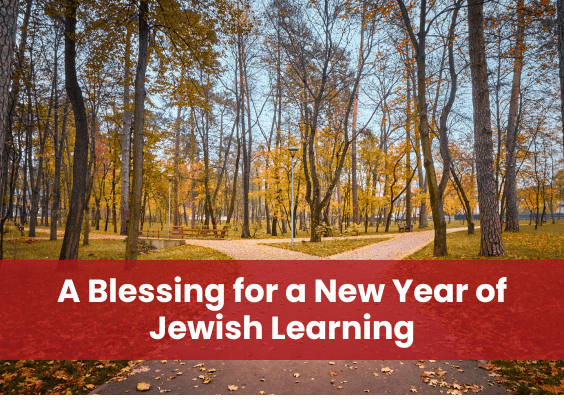
Dr. Samantha Vinokor-Meinrath,
Senior Director of Knowledge, Ideas, and Learning at the Jewish Education Project
(Experiential Educators Program ’15)
It is understood that the rhythms of the Jewish year bring with them four potential ways of marking the time of anticipation that a new year brings:
The fifteenth of Shevat, the New Year for trees
The first of Nisan, the birth of the Jewish nation and the Exodus from Egypt
The first of Elul, the date of tithing of cattle
And of course, the first of Tishrei, Rosh Hashanah – the head of the year. Rosh Hashanah, which often comes just as the school year is kicking off, when the air is ripe with leaves and crisp smells and the anticipation that only comes when a blank notebook is ready to be filled with a new year of ideas and reflections and to-do lists and notes that will be indelibly written in our memories, as well as notes that will be promptly forgotten. Rosh Hashanah, with its rituals of renewal and the timeless, cyclical rhythms of the year.
Rosh Hashanah, with the accompanying anxiety of hurrying to start the school year strong, knowing that it’s soon to be broken up by back to back chagim, trying to figure out how to do community building and teach about all of the holidays, finding new ways to reach learners who are happy to eat round challah but need some extra motivation to be reflective and find meaning in the stories and rituals of the chag, all the while hosting dinners and planning services and thinking ahead to finding replacement schach in time for the sukkah to be built just days later. But no pressure.
As both the start of the Jewish year and the start of the school year, for those of us engaged in the sacred work of Jewish education, Rosh Hashanah packs a double punch. While the traditional greeting exchanged on this new year is Shanah tovah u’metukah – a wish for a good, sweet year – I’m going to offer up a few additional wishes and blessings for the new year of learning.
May this be the start of a year of more questions than answers. Each time we meet with our learners, let’s move beyond the pressures of having to finish the prescribed lesson, or answering every question, or making sure every piece of knowledge is passed on. Instead, let’s embrace the possibility that comes when sentences are left unfinished and there’s still blank space on the page, ready to be filled in by the meaning-making that each learner can create for themselves.
May this be the start of a year of Jewish joy. In a world where the Jewish experience is marked by rising antisemitism, and the ready answer to the existential question of why be Jewish is often enmeshed with an identity rooted in persecution, it’s easy for Jewish conversations to be rooted in fear, or defiance, or uncertainty. But an identity formed by negatives is not appealing; nor is it a foundation for a thriving Jewish life. When it’s easy to get bogged down in the to do list of this peak season of the Jewish calendar, may we prioritize joy in our Jewish journeys and experiences.
May this be the start of a year of dialogue. The canonical Jewish texts are an unfolding, multigenerational conversation that defies the boundaries of time and space. Talmudic rabbis argue across generations, answering one another as colleagues and peers, recognizing the teachings of those who came before them, and adding the voices of each additional generation to the layers that have already been built. We have the opportunity to transform our learners from being students who learn from the past to being active participants in relationship with the compendium of Jewish wisdom, who feel empowered to bring their own voices to the conversations of the sages.
May this be the start of a year of blurred lines. The identity of today’s learner is inherently multifaceted and complex. Each of us has numerous facets of ourselves, and our learners are comfortable and proud to be part of numerous identity and affinity groups. But as it becomes increasingly possible for a bifurcated identity to take shape, and the “Jewish part” of an individual to only thrive in the traditionally Jewish spaces and moments of their lives, may the lines become blurred, with the Jewish self coloring the entirety of a complex life, and all of the aspects of one’s worldview informing the Jewish experience at once.
May this be the start of a year of possibilities.
Shanah tovah u’metukah
Are you a Pardes alum with High Holiday Torah you would like to share? Send us your Torah at community@pardes.org!
Seeking more High Holiday Torah? Visit our High Holiday Torah Hub.
